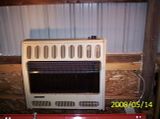magicheater
Veteran Member
What are you planning on doing in there?
1*I agree with Dave1949.
1*Consider a small wall hung propane heater.You can buy vented or unvented models.We use unvented heaters here in no.mn. to heat fish shanties with no problems.The heaters can be bought fairly cheap and don,t cost that much to run.I,d say a 15-20 th.btu unit on a thermistat would work out well.
2*I,d mount it as low to the floor as you can:thumbsupave
 This is a 30000 BTU un vented NG wall heater mounted on the back wall about 6 or 8 inches above the floor .
This is a 30000 BTU un vented NG wall heater mounted on the back wall about 6 or 8 inches above the floor . This is a common 20 inch Box fan mounted on the same wall near the ceiling.
This is a common 20 inch Box fan mounted on the same wall near the ceiling.What ever you use keep it at least 18 inches off the floor to avoid igniting gasoline fumes.
Run the nat. gas line from your house yourself. It isn't that difficult. Don't know the cost of nat. gas in your area,but around here,it's usually cheaper than propane . check the adds for used furnaces..NOTE,,,, Make sure the combustion chamber is ok b-4 you purchase / install a used furnace
Would you run a line from the house to the shed from the high pressure side or the regulated pressure side of the meter? Ken Sweet
Would you run a line from the house to the shed from the high pressure side or the regulated pressure side of the meter? Ken Sweet